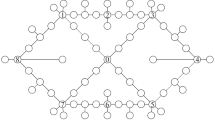Abstract
Shortest-path trees play an important role in the field of optimising fixed-access telecommunication networks with respect to costs and capacities. Distributional properties of the corresponding two half-trees originating from the root of such a tree are of special interest for engineers. In the present paper, we derive parametric approximation formulas for the marginal density functions of the total lengths of both half-trees. Besides, a parametric copula is used in order to combine the marginal distributions of these functionals to a bivariate joint distribution as, naturally, the total lengths of the half-trees are not independent random variables. Asymptotic results for infinitely sparse and infinitely dense networks are discussed as well.











Similar content being viewed by others
References
Daley DJ, Vere-Jones D (2005) An introduction to the theory of point processes, vol I/II. Springer, New York
Fleischer F, Gloaguen C, Schmidt V, Voss F (2009) Simulation of the typical Poisson-Voronoi-Cox-Voronoi cell. J Stat Comput Simul 79:939–957
Friedman JH, Rafsky LC (1979) Multivariate generalizations of the Wald-Wolfowitz and Smirnov two-sample tests. Ann Stat 7: 967–717
Gloaguen C, Voss F, Schmidt V (2011) Parametric distributions of connection lengths for the efficient analysis of fixed access network. Ann Telecommun 66:103–118
Hirsch C, Neuhäuser D, Schmidt V Asymptotic properties of Euclidean shortest-path trees and applications to telecommunication networks. Working paper (under preparation)
Illian J, Penttinen A, Stoyan H, Stoyan D (2008) Statistical analysis and modelling of spatial point patterns. Wiley, Chichester
Mai J-F, Scherer M (2012) Simulating copulas: stochastic models, sampling algorithms, and applications. Imperial College Press, London
Nelsen RB (2006) An introduction to copulas. Springer, New York
Neuhäuser D, Hirsch C, Gloaguen C, Schmidt V (2013) A parametric copula approach for modelling shortest-path trees in telecommunication networks. In: Dudin A, Turck K (eds) Analytical and stochastic modeling techniques and applications. Lecture notes in computer science, vol 7984. Springer, Berlin, pp 324–336
Neuhäuser D, Hirsch C, Gloaguen C, Schmidt V (2012) On the distribution of typical shortest-path lengths in connected random geometric graphs. Queueing Syst 71:199–220
Ruppert D (2010) Statistics and data analysis for financial engineering. Springer texts in statistics, New York
Schneider R, Weil W (2008) Stochastic and integral geometry. Springer, Berlin
Stoyan D, Kendall WS, Mecke J (1995) Stochastic geometry and its applications. Wiley, Chichester
Voss F, Gloaguen C, Fleischer F, Schmidt V (2011) Densities of shortest path lengths in spatial stochastic networks. Stoch Model 27:141–167
Voss F, Gloaguen C, Schmidt V (2010) Scaling limits for shortest path lengths along the edges of stationary tessellations. Adv Appl Probab 42:936–952
Author information
Authors and Affiliations
Corresponding author
Additional information
This work was supported by Orange Labs through Research grant No. 46146063-9241. Christian Hirsch was supported by a research grant from DFG Research Training Group 1100 at Ulm University. Parts of the numerical results were obtained by the help of Jan Sommer.
Rights and permissions
About this article
Cite this article
Neuhäuser, D., Hirsch, C., Gloaguen, C. et al. Joint distributions for total lengths of shortest-path trees in telecommunication networks. Ann. Telecommun. 70, 221–232 (2015). https://doi.org/10.1007/s12243-014-0440-9
Received:
Accepted:
Published:
Issue Date:
DOI: https://doi.org/10.1007/s12243-014-0440-9




